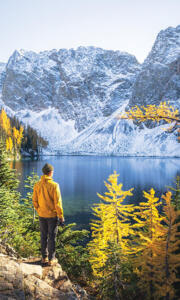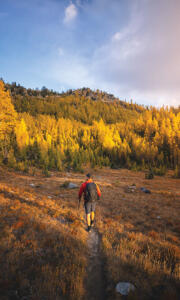Lore of the Larches
Every fall, there’s a stunning visual phenomenon that happens in the Pacific Northwest: small portions of the trees that lace the mountain ranges around us turn a brilliant fire-like yellow. The trees are called larches, and thousands of outdoor enthusiasts rush to the local trails to see the seasonal wonder. But they only shimmer for a few short weeks each year, so here’s a guide about where and when to see the show—and how searching for them can boost your health.
Tronsen Ridge—Blewett Pass
Length: 8 miles round trip
Elevation gain: 1,000 feet
Top elevation: 5,800 feet
Difficulty: Moderate
Drive time: 1 hour 45 minutes from Bellevue
This is the perfect trail for those who are larch hunting for the first time. It’s not a far drive from Seattle, and the mild hike is accessible to everyone. Note: much of the trek through meadows and low ridgelines is exposed and sunny, so even if there’s cooler weather, pack some sun protection and plenty of water.
 Blue Lake
Blue Lake
Length: 4.4 miles round trip
Elevation gain: 1,050 feet
Top elevation: 6,254 feet
Difficulty: Moderate
Drive time: 4-plus hours from Bellevue
If you’re looking for the most bang for your buck, this is the trail. It’s not close to the city, but if you happen to be traveling along North Cascades Highway and want to stop for some tree gazing, Blue Lake is a great option. It’s only a two-mile trek to the summit, but you end up in a whole other world once you reach the top. Massive granite spires surround a gorgeous clear lake that’s lined by the golden trees. Although the trailhead is located right off the highway, it’s a lesser-known trail that few stop to experience.
Carne Mountain
Length: 7.3 miles round trip
Elevation gain: 3,600 feet
Top elevation: 7,085 feet
Difficulty: Hard
Drive time: 2.5–3 hours from Bellevue
The most physically challenging of the bunch is Carne Mountain. You will get a significant workout while scouting larches. With all the work comes a lot of reward, though. You will soak in the majesty of the Entiat Mountains and earn the chance for a double summit. This trail is for adventurers who like to work a little for their views.
Lake Ingalls
Length: 9 miles round trip
Elevation gain: 2,500 feet
Top elevation: 6,500 feet
Difficulty: Hard
Drive time: 2 hours, 25 minutes from Bellevue
Lake Ingalls is a popular hike, so be prepared for other tree lovers. But there’s a reason so many people love it—the trail is nonstop beauty. After wandering through shaded woods, including plenty of larch patches, the final reward is the bright-blue alpine lake featuring Mount Stuart as the backdrop. To maximize your experience, go on a weekday when you might find yourself among only a handful of others.
 Heather—Maple Pass Loop
Heather—Maple Pass Loop
Length: 7.2 miles round trip
Elevation gain: 2,020 feet
Top elevation: 6,650 feet
Difficulty: Moderate/hard
Drive time: 3.5 hours from Bellevue
Possibly the most lauded larch-watching trail in the state, Heather—Maple Pass Loop has a reputation for a reason. Packed brim to brim with larches, this loop trail offers two ways to see the landscape. Starting clockwise or counterclockwise, you’ll stroll through mountain bowls, pass by alpine lakes (be sure to check out Lake Ann) and hike breathtaking ridgelines. Choose your own adventure, because you can’t go wrong either direction. It’s not the closest trail, but well worth the driving miles.
Resources
Want to know more about larches and where to find them in Washington? Check out these guides:
• Fall Color Hikes: Washington, by Tami Asars
• Washington Trail Association, wta.org


